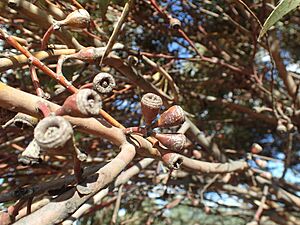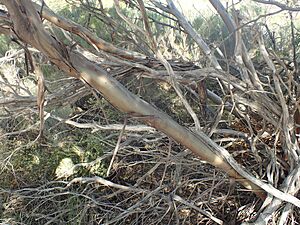Spring mallee facts for kids
Quick facts for kids Spring mallee |
|
|---|---|
 |
|
| Eucalyptus diminuta growing near Arrowsmith | |
| Scientific classification | |
| Genus: |
Eucalyptus
|
| Species: |
diminuta
|
| Synonyms | |
|
Eucalyptus sargentii subsp. fallens L.A.S.Johnson & K.D.Hill |
|
The Spring Mallee, also known as Eucalyptus diminuta, is a special type of tree or bush. It only grows in the southwest part of Western Australia. This plant has smooth, shiny bark that can be silver or grey. Sometimes, it has rough bark near the bottom. Its leaves are shaped like a spear. It grows long, hanging flower buds in groups of seven. When these buds open, they show creamy white flowers. After the flowers, it grows fruit that looks like a cup or a bell.
Contents
What the Spring Mallee Looks Like
The Eucalyptus diminuta is a type of mallee. This means it's a plant that grows many stems from a special woody base called a lignotuber. It usually grows to be about 1.7 to 5 meters (about 5 to 16 feet) tall.
Bark and Leaves
The Spring Mallee has smooth bark that looks silvery or grey. Sometimes, near the bottom of the plant, the bark can be a bit rough and flaky.
Young plants and new shoots have dull, bluish leaves. These leaves are shaped like an egg or a spear. They are about 60 to 90 millimeters (2.4 to 3.5 inches) long and 15 to 30 millimeters (0.6 to 1.2 inches) wide.
Older, adult leaves are shaped like a spear. They are longer, about 50 to 115 millimeters (2 to 4.5 inches) long. They are also narrower, about 6 to 20 millimeters (0.2 to 0.8 inches) wide. These leaves grow on a small stem called a petiole, which is 5 to 26 millimeters (0.2 to 1 inch) long.
Flowers and Fruit
The flower buds of the Spring Mallee grow in groups of seven. They hang down from a thin stem called a peduncle, which is 10 to 25 millimeters (0.4 to 1 inch) long. Each individual bud has its own tiny stem, called a pedicel, which is 1 to 8 millimeters (0.04 to 0.3 inches) long.
When the buds are ready to open, they are long and have a rounded tip. They measure about 18 to 27 millimeters (0.7 to 1.1 inches) long and 4 to 8 millimeters (0.16 to 0.3 inches) wide. The top part of the bud, called the operculum, looks like a cone or a horn.
The Spring Mallee blooms between July and November. Its flowers are a lovely creamy white color. After the flowers, the plant grows woody fruits. These fruits are shaped like a cone, a cup, or a bell. They are about 7 to 12 millimeters (0.28 to 0.47 inches) wide. The parts that open to release seeds are close to the rim of the fruit.
How the Spring Mallee Got its Name
The Eucalyptus diminuta was officially described for the first time in 2002. This was done by two botanists, Ian Brooker and Stephen Hopper. They wrote about it in a science journal called Nuytsia.
The first plant specimen used to describe this species was collected by Brooker. He found it near Glenfield on the road to Yuna.
The second part of its scientific name, diminuta, comes from a Latin word. It means "diminished" or "made smaller." This name was chosen because the Spring Mallee is smaller in size, including its buds and fruit, compared to a similar plant called the E. stowardii.
This species belongs to a large group of Eucalyptus plants. It is closely related to E. stowardii.
Where the Spring Mallee Grows
The Spring Mallee grows in sandy areas and near swamps. You can find it along the west coast of Western Australia. It grows in the Mid West and Wheatbelt regions. It prefers to grow in sandy clay or sandy soils that are on top of a type of rock called laterite.
Protecting the Spring Mallee
The Western Australian Government's Department of Parks and Wildlife has looked at the Spring Mallee. They have decided that it is "not threatened." This means there are enough of these plants, and they are not currently in danger of disappearing.




